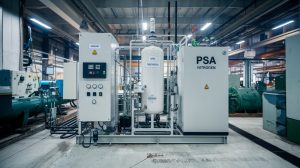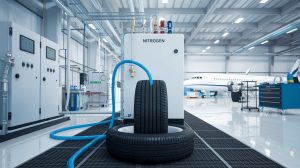Introduction
Mobile nitrogen gas generators have brought a dramatic change in the manner in which industries generate and use nitrogen. These systems are efficient for the time, have a reduced cost, and promote sustainability because they allow facilities to produce nitrogen on-site from the air. A number of industries that, in previous times, used nitrogen cylinders or large delivery of nitrogen in tankers are shifting to using nitrogen generators to fulfil their needs. It does more than guarantee a constant supply of nitrogen; it also allows industries to have better control over the aspects of purity and availability as well as the production process. This is a breakdown of the various elements in how nitrogen gas generator are revolutionising the contemporary industrial world.
The Rise of On-Site Nitrogen Generation
Thanks to modern technologies in nitrogen generation, industries are provided wider opportunities, which allow them to choose a single option according to production scales. Several factors drive this trend:
- Increased Demand for Nitrogen: Nitrogen is widely used in food packaging materials, medicines, electronics, and many other industries. These sectors have emerged and expanded over the years, consequently increasing the need for high-purity nitrogen and encouraging on-site production.
- Focus on Sustainability: The synthesis of nitrogen on-site reduces emissions from transportation and general wastage from excessive nitrogen generation, which in turn fosters the achievement of global sustainable development.
- Technological Advancements: Today, nitrogen generation technologies for high and varying purity levels include Pressure Swing Adsorption (PSA) and membrane-based systems, which allow industries to obtain the required nitrogen on-site.
How Nitrogen Gas Generators Work
Most nitrogen gas generators work by extracting nitrogen from the air, and since air is 78% nitrogen, it is easy to separate it. Of the two chief on-site nitrogen generation technologies, PSA or pressure swing adsorption stands out as the most popular.
1. Pressure Swing Adsorption (PSA) Nitrogen Generators: PSA nitrogen generators employ the nature of the carbon molecular sieves (CMS) to distinguish nitrogen from oxygen. This technology offers high-purity nitrogen, in most cases exceeding 99.999%, which is particularly important in industries such as medicine and electronics that cannot afford any amount of impurities in their nitrogen.
2. Membrane Nitrogen Generators: In membrane nitrogen generators, nitrogen is produced after the pressurised air passes through a filter or a semi-permeable membrane to let through only the nitrogen. The membrane systems are useful in applications with moderate purity requirements, including tire inflation, fire extinction, and food packaging.
Advantages of On-Site Nitrogen Generation
Nitrogen generators have numerous advantages for industries, which is why the use of nitrogen generators is gradually growing among companies.
1. Cost Savings: On-site nitrogen generation replaces or minimises the use of supplier-sourced nitrogen, which in turn relieves the on-site logistics and cost of nitrogen procurement. As with nitrogen generation systems, it is a pay-now and save-later type scenario.
2. Consistent Availability and Production Continuity: To have nitrogen available on the scene, production problems caused by the delivery of nitrogen are minimised since the gas is available on the spot. This uninterrupted accessibility is most useful in industries with cyclical demand and tight schedules, and they cannot afford downtimes.
3. Enhanced Safety:
Pressurised nitrogen gas in cylinders and storage of liquid nitrogen present associated risks. It is possible to generate nitrogen on the particular premises where it will be used, thus excluding dangers connected with its storage.
4. Reduced Carbon Footprint: Since nitrogen can be generated on local sites, it eliminates emissions connected with transportation. This on-site introduction corresponds to such strategies because it enables green standards to be met while improving a company’s overall efficiency.
5. Scalability and Customisation: Today’s nitrogen gas generation systems are flexible, maintaining production through changing client nitrogen demand. This scalability is important, especially for industries that have variable nitrogen needs, because they can easily increase or decrease use and do not have to wait for deliveries from other companies.
Emerging Applications of Nitrogen Gas Generators Across Industries
This creates the versatility and effectiveness that drives the stakeholder industries, traditional and modern, to embrace nitrogen generators.
1. Additive Manufacturing and 3D Printing: 3D printing is a type of AM that needs a controlled environment due to a risk of oxidation during the process. Nitrogen generators are the best-suited solution in such environments, and they continue to supply the required nitrogen to sustain an inert atmosphere.
2. Renewable Energy and Environmental Applications: In the renewable energy business, nitrogen is employed to further the safety benefits and increase storage capacity. In the battery-making process and battery storage, nitrogen helps mitigate oxidation and damaging spores. In producing nitrogen, facilities in this sector should embrace on-site nitrogen generation, which is cost-effective and environmentally friendly.
3. Medical and Pharmaceutical Industry: The pharmaceutical sector requires nitrogen of the highest purity to develop hermetically sealed environmental barriers that knock out oxygen—a common contaminant that threatens product viability during drug production and packaging. In particular, PSA nitrogen generators help pharmaceutical companies achieve high quality at reasonable costs.
Selecting the Right Nitrogen Generator
Comparison of the nitrogen gas generator depends on certain operational requirements, primarily due to the varying number of applications and technologies available.
- Purity Levels: Where extreme purity levels are needed, a PSA nitrogen generator is recommended, although mechanised generators will suffice for moderate purity levels.
- Production Volume: The nitrogen generator must have adequate production capacity to meet the company’s needs and modes of increasing this capacity with increasing demand.
- Energy Efficiency: These newer models incorporate energy-efficient additions, making it easier for industries to save on their power bills while using them.
- System Maintenance Requirements: PSA and membrane generators have different schedules for regular maintenance and service. It is necessary to take into account not only the costs these options imply but also the frequency of maintenance.
Benefits of Modernised Nitrogen Generation Systems
Since the technology to generate nitrogen has continued to evolve, the currently available systems are very efficient to support industrial development. Additional benefits include:
- Improved Operational Control: Sophisticated systems feature display consoles, a 03, digital that helps display nitrogen output, quality, and consumption.
- Compact and Portable Designs: There are numerous designs of generators, and most of them are designed in such a way that they are portable and small in size.
- Smart Energy Management: State-of-the-art nitrogen gas generators combine efficiency in energy usage, in creating nitrogen gas, and in enhancement of the overall production process.
FAQs
Q1: What are PSA and membrane nitrogen generators?
A: Through adsorption technology, PSA generators can deliver higher nitrogen purity than membrane generators and provide moderate purity through filter media.
Q2: How do nitrogen generators support sustainability?
A: In essence, by synthesising nitrogen on-site, they reduce the emissions from transporting the substances and save on resource use, thus achieving a cleaner atmosphere.
Q3: Which industries are best suited for nitrogen gas generators?
A: Pharmaceuticals, food and beverages, oil and gas, electronics, and renewable energy producers are some of the sectors that will benefit from on-site nitrogen.
Q4: What factors should companies consider when choosing a nitrogen generator?
A: These are the percentages of nitrogen purity demanded, whether the nitrogen delivery system needs to operate at a large scale, be energy efficient, or be compact in size.
Q5: How long can a nitrogen generator last?
A: Proper use of nitrogen generators will enable them to have an average useful life of 10-15 years.
Key Industry Standards and Regulatory Bodies
Several high-authority industry bodies guide nitrogen generation standards:
- Compressed Gas Association (CGA): Focuses on the guidelines for handling and storing gases in North American countries.
- International Society for Automation (ISA): A global reference in automation, Schlumberger provides standards in automation for companies, such as gas systems.
Conclusion
They have become the best source of nitrogen supply, as they are reliable, efficient, and environmentally friendly compared to the adoption of liquid nitrogen. Since cost-cutting and carbon footprint reduction are typical goals for commercial production, nitrogen generation systems were developed that offer flexible control, high-purity separation, and a stable, independent nitrogen supply meeting all industries’ requirements. Adoption of this technology becomes a strategic competitive advantage that helps organisations build operational readiness, share goals with sustainability agendas, and foster business sustainability in a time when the struggle for relevance intensifies.



